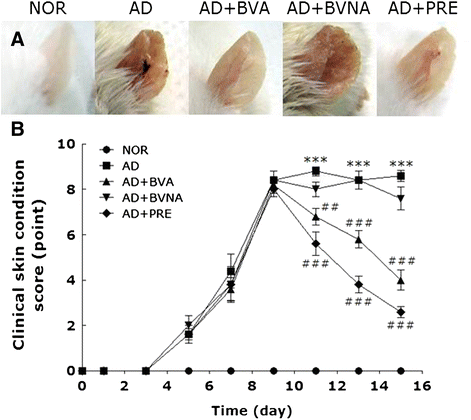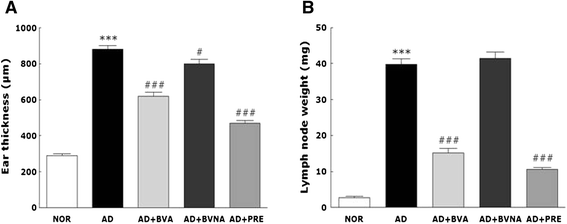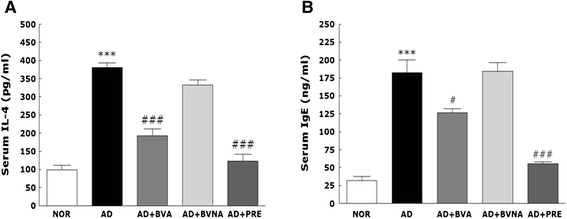Bee venom acupuncture alleviates trimellitic anhydride-induced atopic dermatitis-like skin lesions in mice
- PMID: 26825274
- PMCID: PMC4731956
- DOI: 10.1186/s12906-016-1019-y
Bee venom acupuncture alleviates trimellitic anhydride-induced atopic dermatitis-like skin lesions in mice
Abstract
Background: Bee venom acupuncture (BVA), a novel type of acupuncture therapy in which purified bee venom is injected into the specific acupuncture point on the diseased part of the body, is used primarily for relieving pain and other musculoskeletal symptoms. In the present study, therapeutic potential of BVA to improve atopic dermatitis, a representative allergic dysfunction, was evaluated in the mouse model of trimellitic anhydride (TMA)-induced skin impairment.
Methods: Mice were treated with 5% TMA on the dorsal flank for sensitization and subsequently treated with 2% TMA on the dorsum of both ears for an additional 12 days after a 3-day interval. From the 7(th) day of 2% TMA treatment, bilateral subcutaneous injection of BV (BV, 0.3 mg/kg) was performed daily at BL40 acupuncture points (located behind the knee) 1 h before 2% TMA treatment for 5 days.
Results: BVA treatment markedly inhibited the expression levels of both T helper cell type 1 (Th1) and Th2 cytokines in ear skin and lymph nodes of TMA-treated mice. Clinical features of AD-like symptoms such as ear skin symptom severity and thickness, inflammation, and lymph node weight were significantly alleviated by BV treatment. BV treatment also inhibited the proliferation and infiltration of T cells, the production of Th1 and Th2 cytokines, and the synthesis of interleukin (IL)-4 and immunoglobulin E (IgE)-typical allergic Th2 responses in blood. The inhibitory effect of BVA was more pronounced at BL40 acupoint than non-acupuncture point located at the base of the tail.
Conclusions: These results indicate that BV injection at specific acupuncture points effectively alleviates AD-like skin lesions by inhibiting inflammatory and allergic responses in a TMA-induced contact hypersensitivity mouse model.
Figures







Similar articles
-
Piperine Ameliorates Trimellitic Anhydride-Induced Atopic Dermatitis-Like Symptoms by Suppressing Th2-Mediated Immune Responses via Inhibition of STAT6 Phosphorylation.Molecules. 2020 May 7;25(9):2186. doi: 10.3390/molecules25092186. Molecules. 2020. PMID: 32392825 Free PMC article.
-
Silkworm dropping extract ameliorate trimellitic anhydride-induced allergic contact dermatitis by regulating Th1/Th2 immune response.Biosci Biotechnol Biochem. 2018 Sep;82(9):1531-1538. doi: 10.1080/09168451.2018.1475210. Epub 2018 May 26. Biosci Biotechnol Biochem. 2018. PMID: 29806566
-
Anti-Inflammatory Effects of Cold Thermal Therapy on Allergic Skin Inflammation Induced by Trimellitic Anhydride in BALB/c Mice.Mediators Inflamm. 2019 Jan 28;2019:1936769. doi: 10.1155/2019/1936769. eCollection 2019. Mediators Inflamm. 2019. PMID: 30833826 Free PMC article.
-
Bee Venom Acupuncture Effects on Pain and Its Mechanisms: An Updated Review.Toxins (Basel). 2021 Aug 29;13(9):608. doi: 10.3390/toxins13090608. Toxins (Basel). 2021. PMID: 34564611 Free PMC article. Review.
-
Bee Venom Acupuncture for Shoulder Pain: A Literature Review of Clinical Studies.Toxins (Basel). 2024 Nov 20;16(11):501. doi: 10.3390/toxins16110501. Toxins (Basel). 2024. PMID: 39591256 Free PMC article. Review.
Cited by
-
Electro-Acupuncture at Zusanli Acupoint (ST36) Suppresses Inflammation in Allergic Contact Dermatitis Via Triggering Local IL-10 Production and Inhibiting p38 MAPK Activation.Inflammation. 2017 Aug;40(4):1351-1364. doi: 10.1007/s10753-017-0578-5. Inflammation. 2017. PMID: 28493082
-
Acupuncture for atopic dermatitis: a systematic review and meta-analysis.BMJ Open. 2024 Dec 5;14(12):e084788. doi: 10.1136/bmjopen-2024-084788. BMJ Open. 2024. PMID: 39638592 Free PMC article.
-
Study on the Molecular Basis of Huanglian Jiedu Decoction Against Atopic Dermatitis Integrating Chemistry, Biochemistry, and Metabolomics Strategies.Front Pharmacol. 2021 Dec 14;12:770524. doi: 10.3389/fphar.2021.770524. eCollection 2021. Front Pharmacol. 2021. PMID: 34970141 Free PMC article.
-
Immunology of Bee Venom.Clin Rev Allergy Immunol. 2018 Jun;54(3):386-396. doi: 10.1007/s12016-017-8597-4. Clin Rev Allergy Immunol. 2018. PMID: 28105558 Review.
-
Biological Effects of Animal Venoms on the Human Immune System.Toxins (Basel). 2022 May 16;14(5):344. doi: 10.3390/toxins14050344. Toxins (Basel). 2022. PMID: 35622591 Free PMC article. Review.
References
Publication types
MeSH terms
Substances
LinkOut - more resources
Full Text Sources
Other Literature Sources
Medical

